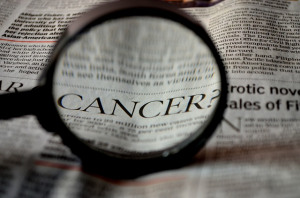
Analysis of data from the Netherlands Cohort Study shows that higher toenail selenium concentrations are associated with a substantial reduction in the risk of advanced prostate cancer. Men in the highest quintile of toenail selenium had a statistically significant (p=0.001) 63% reduced risk of advanced (stage III-IV) prostate cancer compared to men in the lowest quintile of toenail selenium [Geybels].
Men in the highest quintile of toenail selenium concentrations had a toenail selenium level higher than 0.617 micrograms of selenium per gram of toenail. Men in the lowest quintile of toenail selenium concentrations has a toenail selenium level lower than 0.469 micrograms of selenium per gram of toenail [Geybels].
The quintile medians of toenail selenium in the study ranged from 0.43 (lowest) to 0.67 (highest) micrograms of selenium per gram of toenail.
These toenail selenium levels correspond to plasma selenium levels ranging from 64 to 100 micrograms of selenium per liter of plasma [Geybels].
Effective levels of selenium for reduction of cancer risk
The Dutch researchers concluded that the selenium levels seen in their study are in the range in which additional selenium can be expected to be beneficial [Geybels].
Three earlier high-quality studies of toenail selenium and cancer risk had already indicated a significant reduction in prostate cancer risk (estimated RR: 0.29; 95% CI: 0.14, 0.61) with a toenail selenium concentration between 0.85 and 0.94 micrograms of selenium per gram of toenail [Hurst 2010].
Age at diagnosis for prostate cancer and smoker/non-smoker status
The Dutch researchers noted that the association between the level of toenail selenium and the risk of advanced prostate cancer was somewhat more pronounced in two sub-groups:
- those men whose prostate cancer was diagnosed at an older age
- those men who were or had been smokers as compared to never-smokers
The association of selenium protection against cancer in smokers makes sense in that cigarette smoking is associated with increased oxidative stress, and selenium is a component of important antioxidant selenoproteins [Geybels].
Design of The Netherlands Cohort Study and toenail selenium analysis
The Netherlands Cohort Study included 58,279 men aged 55 to 69 years at baseline. Approximately 79% of the men in the study provided toenail clippings for analysis. In 17.3 years of follow-up, the Dutch researchers were able to compare the toenail selenium levels in 898 men with advanced prostate cancer with the toenail selenium levels in 1176 sub-cohort men [Geybels].
The average toenail selenium concentration of the men in the control group was 0.55 micrograms of selenium per gram of toenail.
Compared with the men in the control sub-group, the men diagnosed with advanced prostate cancer had two other interesting characteristics [Geybels]:
- They were more likely to have a first-degree relative with prostate cancer.
- They were less likely to have a history of diabetes.
The advantage of using toenail selenium measurements in cancer studies
Selenium concentrations in toenails are regarded as a more accurate measure of individual exposure to selenium over a longer period, e.g. six months to one year. In contrast, serum or plasma selenium concentrations seem to show the extent of recent exposure to selenium, e.g. in recent weeks [Geybels].
Conclusion: selenium exposure and prostate cancer
- Selenium is an essential micronutrient [Geybels].
- In the human body, selenium is incorporated into the amino acid selenocysteine and, as a component of selenocysteine, into various antioxidant selenoproteins [Geybels].
- The intake of selenium varies widely depending upon the selenium content of the soil and the food of a particular region [Geybels].
- Selenium concentrations are generally lower in Europe and the Middle East than they are in the United States, but there are also regions of the United States in which low selenium levels may be common [Stoffaneller & Morse; Park].
- Several studies and meta-analyses have shown an inverse association between selenium levels and the risk of prostate cancer, especially advanced prostate cancer [Hurst; Etminan]
- A 2018 meta-analysis indicates that selenium most probably has a protective role against the development of prostate cancer and its progression to advanced stages [Sayehmiri].
Sources
Cui, Z., Liu, D., Liu, C., & Liu, G. (2017). Serum selenium levels and prostate cancer risk: A MOOSE-compliant meta-analysis. Medicine, 96(5), e5944.
Etminan, M., FitzGerald, J. M., Gleave, M., & Chambers, K. (2005). Intake of selenium in the prevention of prostate cancer: a systematic review and meta-analysis. Cancer Causes & Control: CCC, 16(9), 1125–1131.
Geybels, M. S., Verhage, B. J., van Schooten, F. J., Goldbohm, R. A., & van den Brandt, P. A. (2013). Advanced prostate cancer risk in relation to toenail selenium levels. Journal of The National Cancer Institute, 105(18), 1394-1401.
Hurst, R., Hooper, L., Norat, T., Lau, R., Aune, D., Greenwood, D. C., & Fairweather-Tait, S. J. (2012). Selenium and prostate cancer: systematic review and meta-analysis. The American Journal of Clinical Nutrition, 96(1), 111-122.
Hurst, R., Armah, C.N., Dainty J.R., Hart, D.J., Teucher, B., Goldson, A.J., Broadley, M.R., Motley, A.K., Fairweather-Tait, S.J. (2010). Establishing optimal selenium status: results of a randomized, double-blind, placebo-controlled trial. Am J Clin Nutr, 91(4):923-31.
Park, K., Rimm, E., Siscovick, D., Spiegelman, D., Morris, J. S., & Mozaffarian, D. (2011). Demographic and lifestyle factors and selenium levels in men and women in the U.S. Nutrition Research and Practice, 5(4), 357–364.
Sayehmiri, K., Azami, M., Mohammadi, Y., Soleymani, A., & Tardeh, Z. (2018). The association between Selenium and Prostate Cancer: a Systematic Review and Meta-Analysis. Asian Pacific Journal of Cancer Prevention: APJCP, 19(6), 1431–1437.
Stoffaneller, R., & Morse, N. L. (2015). A review of dietary selenium intake and selenium status in Europe and the Middle East. Nutrients, 7(3), 1494–1537.
The information contained in this review article is not intended as medical advice and should not be used as such.
